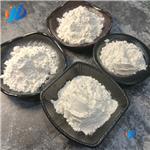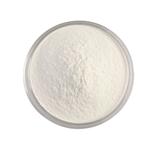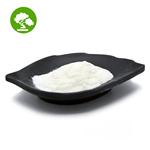- Pepsin
-

- $15.00/ kg
-
2024-04-28
- CAS:9001-75-6
- Min. Order: 1kg
- Purity: 99.912%
- Supply Ability: 10ton
- Pepsin
-

- $240.00 / 1kilograms
-
2024-04-28
- CAS:9001-75-6
- Min. Order: 1kilograms
- Purity: 99%
- Supply Ability: 100tons
- Pepsin
-

- $0.00 / 25kg
-
2024-04-12
- CAS:9001-75-6
- Min. Order: 1kg
- Purity: 99%
- Supply Ability: 2000ton
Related articles - Function and Applications of Pepsin
- Pepsin is one of three principal endopeptidases (enzymes cutting proteins in the middle) in the human digestive system, the ot....
- Jul 5,2022
|
| Product Name: | Pepsin | | Synonyms: | Pepsine from porcine (high activity, 1: 50000) lyophil.;Pepsin ,>0.7 Ph.Eur.U/Mg (activity);OMniTrace Ultra (TM) Perchloric Acid;Pepsin(porcine stoMach Mucose);AVIANPEPSIN;PEPSIN, 1:10,000, U.S.P/NF;Pepsin,elixerlactateofpepsin;Pepsin, 250 units/Mg | | CAS: | 9001-75-6 | | MF: | n.a. | | MW: | 0 | | EINECS: | 232-629-3 | | Product Categories: | Enzymes;API | | Mol File: | Mol File | ![Pepsin Structure]() |
| | Pepsin Chemical Properties |
| alpha | D26 -64.5° (water pH 4.6) | | density | 1.287 g/cm3 | | storage temp. | -20°C | | solubility | 10 mM HCl: soluble1.0mg/mL, clear to faintly turbid, colorless | | form | powder | | color | slightly beige | | Odor | Odorless | | Water Solubility | Soluble in water and dilute aqueous buffers | | Sensitive | Hygroscopic | | Merck | 13,7225 | | Stability: | Stable. Incompatible with strong bases, alkalies, metallic salts, alcohols. | | CAS DataBase Reference | 9001-75-6 | | EPA Substance Registry System | Pepsin A (9001-75-6) |
| Provider | Language |
|
Pepsin
| English |
| | Pepsin Usage And Synthesis |
| Overview | Pepsin is a kind of endopeptidase that breaks down proteins into smaller peptides (that is, a protease). It is biologically produced in the animal stomach and is one of the main digestive enzymes in the digestive systems of humans and many other animals, where it helps digest the proteins in food. Pepsin is an important acidic protease that is widely applied in the hydrolysis of proteins. It is used in collagen extraction[1-3] in gelatin extraction[4] as a rennet substitute[5] and in digestibility therapy[6]. Pepsin has been isolated and investigated from various mammals including: human, Japanese monkey, pig, bovine, goat, rat, and rabbit. Pepsin can be found primarily in the gastric juice of the stomach lumen and can be isolated from a variety of species such as human, cattles, sheeps, birds and fish[7,8]. The main location of pepsin in mammals is the stomach (both the membrane and the gastric juice) but it can also be found in limited amounts in the blood, muscle and the urine[7].
There are several types of stomach pepsins, each has a distinct protein structure and enzymatic properties[9]. Pepsin has a three-dimensional structure, of which one or more polypeptide chains twist and fold, bringing together a small number of amino acids to form the active site, or the location on the enzyme where the substrate binds and the reaction takes place. Pepsin is an aspartic protease, using a catalytic aspartate in its active site[10].
| | Biological location and functions | Pepsin is synthesized and secreted in the gastric membrane in an inactive state called pepsinogen (PG) (molecular weight of 40kDa). Compared with pepsin, pepsinogen contains an additional 44 amino acids and is stable in neutral and weak alkaline environments, but when exposed to the hydrochloric acid (HCl) present in gastric juice (pH of 1.5 – 2.0), the 44 amino acids are proteolytically removed in an autocatalytic way to activate it to pepsin[11]. Its main role in protein proteolysis is to cleave aromatic amino acids (such as phenylalanine and tyrosine) from the N–terminus of proteins[11].
Pepsin is one of three principal proteases in the human digestive system with the other two being chymotrypsin and trypsin. During the process of digestion in the digestive system, these enzymes, each of which is specialized in severing links between particular types of amino acids, collaborate to break down dietary proteins into their components, i.e., peptides and amino acids, which can be readily absorbed by the small intestine. Pepsin is most efficient in cleaving peptide bonds between hydrophobic and preferably aromatic amino acids such as phenylalanine, tryptophan, and tyrosine12. Pepsin's proenzyme, pepsinogen, is released by the chief cells in the stomach wall, and upon mixing with the hydrochloric acid of the gastric juice, pepsinogen activates to become pepsin13.
| | Factor affecting the activity of pepsin | The activity of pepsin can be strongly affected by pH, temperature and inhibitors.
pH
Both the optimum pH (the pH value giving the highest enzymatic activity) and pH stability (the pH range giving good enzyme stability) have significant effects on the activity of pepsin. When the pH deviates from the optimum value, the activity of pepsin drops. Generally, pepsin stability is mentioned at lower pH values. Pepsin is a type of acidic protease and depression of its stability is attributed to the denaturation of proteins above the pH of 6.0. Study has found that the stability and activity of pepsin showed that 70% of maximal peptic activity was present at pH4.5 and that pepsin was irreversibly inactivated at pH 8[14]. Pepsin exhibits maximal activity at pH 2.0 and is inactive at pH 6.5 and above[15, 16].
Temperature
Temperature has a great influence on the activity of pepsin. Like pH, the optimum temperature and thermal stability range are very important. Pepsin is most active in acidic environments between 37 °C and 42 °C[17].
Inhibitors
Pepstatin A (a typical aspartic proteinase inhibitor) can combine with pepsin and prevents the binding of the enzyme to substrate, thereby resulting in a complete inhibition of its activity.
Pepstatin A is a peptide isolated from several species of actinomyces, such as Streptomyces spp. It has one of the lowest known inhibitions constant (Ki= 45 pM) for pepsin[18, 19].
| | Applications | Medical research
Pepsin is utilized in regulation of digestion, as a dental antiseptic and in treatment of ailment including dyspepsia, gastralgia, obstinate vomiting, infantile diarrhea, apepsia and some cancer[5]. Combined with HCl, pepsin tablets and capsules have been developed to support the digestibility in the gastrointestinal tract as well as to enhance the appetite of patients [6]. Pepsin from porcine stomach is used for treatment of gastric ulcers with bismuth complexes added[7]. Pepsin is also added for better digestibility of proteins in animals feed.
Pepsin is also commonly used in the preparation of F(ab')2 fragments from antibodies [23].
Cheese making
Animal (calf, bovine and porcine sources) rennet is composed of pepsin and chymosin commonly mixed in a ratio of 1:9 and used in commercial cheese making. During the food manufacturing process, pepsin is very useful in: modifying and providing whipping qualities to soy protein and gelatin, modifying vegetable proteins for use in nondairy snack items, making precooked cereals into instant hot cereals, and preparing animal and vegetable protein hydrolysates for use in flavoring foods and beverages[24].
Collagen extraction
Conventionally, collagen is extracted by an acid-solubilization process (ASP) in which collagen is solubilized in an acid (such as acetic acid) and other non-acid-soluble materials are removed. Since pepsin can break down cross-linkages in the telo peptide regions of collagen without harming to its secondary structure, the use of pepsin in this process can effectively enhance the yield of collagen[25].
Purification
The process of partitioning of pepsin commonly involves three steps: (a) extraction of pepsinogen which involves preparation of stomach and crude extract, (b) purification of pepsinogen and (c) activation of pepsinogen to pepsin. All these steps are conducted at low temperatures (≤ 4ºC) to prevent denaturation of proteins[26].
| | References |
- Jongjareonrak A, Benjakul S, Visessanguan W, Nagai T, Tanaka M (2005) Isolation and characterisation of acid and pepsin–solubilised collagens from the skin of brownstripe red snapper (Lutjanus vitta). Food Chem 93: 475-484.
- Zhang Y, Liu W, Li G, Shi B, Miao Y, et al. (2007) Isolation and partial characterization of pepsin-soluble collagen from the skin of grass carp (Ctenopharyngodon idella). Food Chem 103: 906-912.
- Nalinanon S, Benjakul S, Visessanguan W, Kishimura H (2007) Use of pepsin for collagen extraction from the skin of bigeye snapper (Priacanthustayenus). Food Chem104: 593-601.
- Nalinanon S, Benjakul S, Visessanguan W, Kishimura H (2008) Improvement of gelatin extraction from bigeye snapper skin using pepsin-aided process in combination with protease inhibitor. Food Hydrocolloids 22: 615-622.
- Aehle W (2007) Enzymes in industry: production and applications. (3rdedn), Wiley–VCH, Weinheim, Germany, 136-137.
- Thorne Research (2010) Betaine HCl and Pepsin; Dover, USA. Sogawa K, Fujii–Kuriyama Y, Mizukami Y, Ichihara Y, Takahashi T (1983) Primary structure of human pepsinogen gene. J Biol Chem 258: 5306-5311.
- Fruton JS (1971) Hydrolysis: peptide bonds, (3rd edn), Academic Press Inc: New York 3: 120-152.
- Effront J, Prescott SC, Venable CS (2007) Biochemical catalysts in life and industry: proteolytic enzymes. Kessinger Publishing: 151-289.
- Shahidi F, Janak Kamil YVA (2001) Enzymes from fish and aquatic invertebrates and their application in the food industry. Trends Food Sci Technol 12: 435-464.
- https://enzyme.expasy.org/EC/3.4.23.1
- Raufman J (2004) Pepsin. In Encyclopedia of Gastroenterology, Johnson L R. Ed., Academic Press, Amsterdam 3: 147-148.
- https://www.britannica.com/science/pepsin
- Kageyama, T, and K. Takahashi. "Occurrence of two different pathways in the activation of porcine pepsinogen to pepsin." Journal of Biochemistry 93.3(1983):743-754.
- Piper, D. W., and B. H. Fenton. "pH stability and activity curves of pepsin with special reference to their clinical importance." Gut 6.5(1965): 506-508.
- Squires EJ, Haard NF, Feltham LA (1986) Gastric proteases of the Greenland cod Gadus ogac. I. Isolation and kinetic properties. Biochem Cell Biol 64: 205-214.
- Johnston N, Dettmar PW, Bishwokarma B, Lively MO, Koufman JA (Jun 2007). "Activity/stability of human pepsin: implications for reflux attributed laryngeal disease". The Laryngoscope. 117 (6): 1036–9.
- http://www.worthington-biochem.com/introbiochem/effectspH.html
- Umezawa H, Aoyagi T, Morishima H, Matsuzaki M, Hamada M (1970) Pepstatin, a new pepsin inhibitor produced by agtinomygetes. J Antibiot (Tokyo) 23: 259-262.
- Zollner H (1999) Handbook of enzyme inhibitors. (3thedn), Wiley–VCH, Chichester, UK, 440-445.
- Gorgas FJS (2009) Dental medicine. A manual of dental material medica and therapeutics, Nabu Press, Washington, 48-50.
- Murado MA, González MDP, Vázquez JA (2009) Recovery of proteolytic and collagenolytic activities from viscera by-products of rayfish (Raja clavata). Mar Drugs 7: 803-815.
- Almås KA (1990) Utilization of marine biomass for production of microbial growth media and biochemicals. In Advances in Fisheries Technology and Biotechnology for increased profitability, Voigt MN, Botta JR, Eds., Technomic Publishing Company, Lamcaster, 361-372.
- Falkenburg WJ, van Schaardenburg D, Ooijevaar-de Heer P, Tsang-A-Sjoe MW, Bultink IE, Voskuyl AE, Bentlage AE, Vidarsson G, Wolbink G, Rispens T (2016). "Anti-Hinge Antibodies Recognize IgG Subclass- and Protease-Restricted Neoepitopes". Journal of Immunology.
- Kun LY (2006). Microbial Biotechnology: Principles And Applications. World Scientific Publishing Company.
- Jongjareonrak A, Benjakul S, Visessanguan W, Nagai T, Tanaka M (2005) Isolation and characterisation of acid and pepsin–solubilised collagens from the skin of brownstripe red snapper (Lutjanus vitta). Food Chem 93: 475-484.
- Roe SD (2001) Purification strategy. In Protein purification techniques (2ndedn), Roe S, Eds, Oxford University Press Inc, New York, 1-10.
| | Chemical Properties | Pepsin is a white or pale yellow powder extracted from the gastric mucosa of pigs, sheep or cattle. Soluble in water, the aqueous solution is acidic. Isoelectric point pH=1. Insoluble in ethanol, chloroform, ether. It is non-toxic and has a special smell of meat; it is hygroscopic. The dry enzyme is relatively stable and will not be inactivated when heated to 1000C for 10min. Its aqueous solution is heated to above 700C or above pH6.2 and begins to inactivate, and when pH>8, it is irreversibly inactivated. It is relatively stable in strong acid solution, and the optimum pH is 1.5-2. Its digestibility is strongest when it contains 0.2% to 0.4% hydrochloric acid (pH 1.6 to 1.8), so it is often used in combination with dilute hydrochloric acid. | | Uses | Pepsin is an enzyme that is secreted in the digestive track of mammals. It works to break down proteins into smaller peptides which can readily be absorbed by the small intestine. | | Preparation | Pepsin is a stomach enzyme that serves to digest proteins found in ingested food. Production method of pepsin: using porcine gastric mucosa as raw material, after extraction with phosphate buffer solution, use DEAE-cellulose column chromatography, and after acidification, use Sephadex C-25 and Sephadex G-25 column chromatography again to refine the product. | | Definition | pepsin is an enzyme that catalysesthe breakdown of proteins topolypeptides in the vertebrate stomach.It is secreted as an inactive precursor,pepsinogen. | | General Description | Pepsin powder is prepared from the gastric mucosa of pigs, cattle or sheep. | | Biochem/physiol Actions | Unlike many other peptidases, pepsin hydrolyzes only peptide bonds, not amide or ester linkages. The cleavage specificity includes peptides with an aromatic acid on either side of the peptide bond, especially if the other residue is also an aromatic or a dicarboxylic amino acid. Increased susceptibility to hydrolysis occurs if there is a sulfur-containing amino acid close to the peptide bond, which has an aromatic amino acid. Pepsin will also preferentially cleave at the carboxyl side of phenylalanine and leucine, and to a lesser extent at the carboxyl side of glutamic acid residues. It does not cleave at valine, alanine, or glycine linkages. Z-L-tyrosyl-L-phenylalanine, Z-L-glutamyl-L-tyrosine, or Z-L-methionyl-L-tyrosine may be used as substrates for pepsin digestion. Pepsin is inhibited by several phenylalanine-containing peptides. | | Purification Methods | Pepsin is re-chromatographed on a column of Amberlite CG-50 using a pH gradient prior to use. Crystallise it from EtOH. [Richmond et al. Biochim Biophys Acta 29 453 1958, Huang & Tang, J Biol Chem 244 1085 1969, 245 2189 1970.] |
| | Pepsin Preparation Products And Raw materials |
|